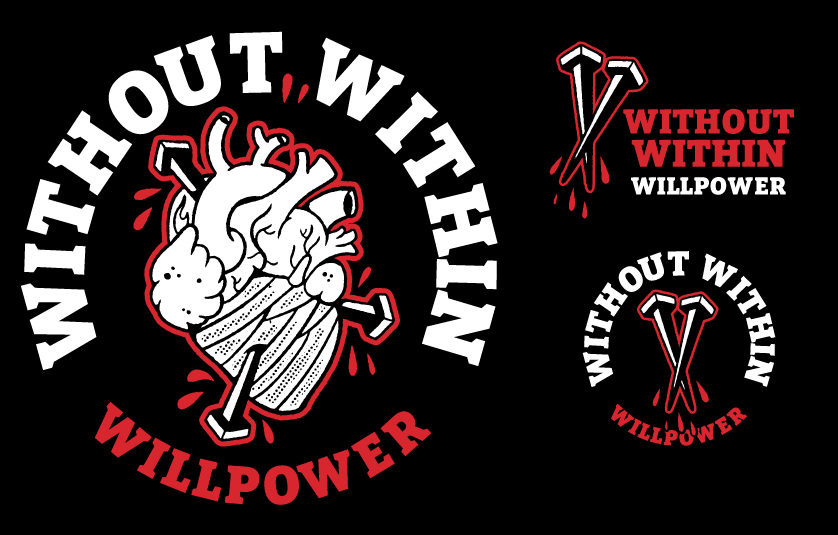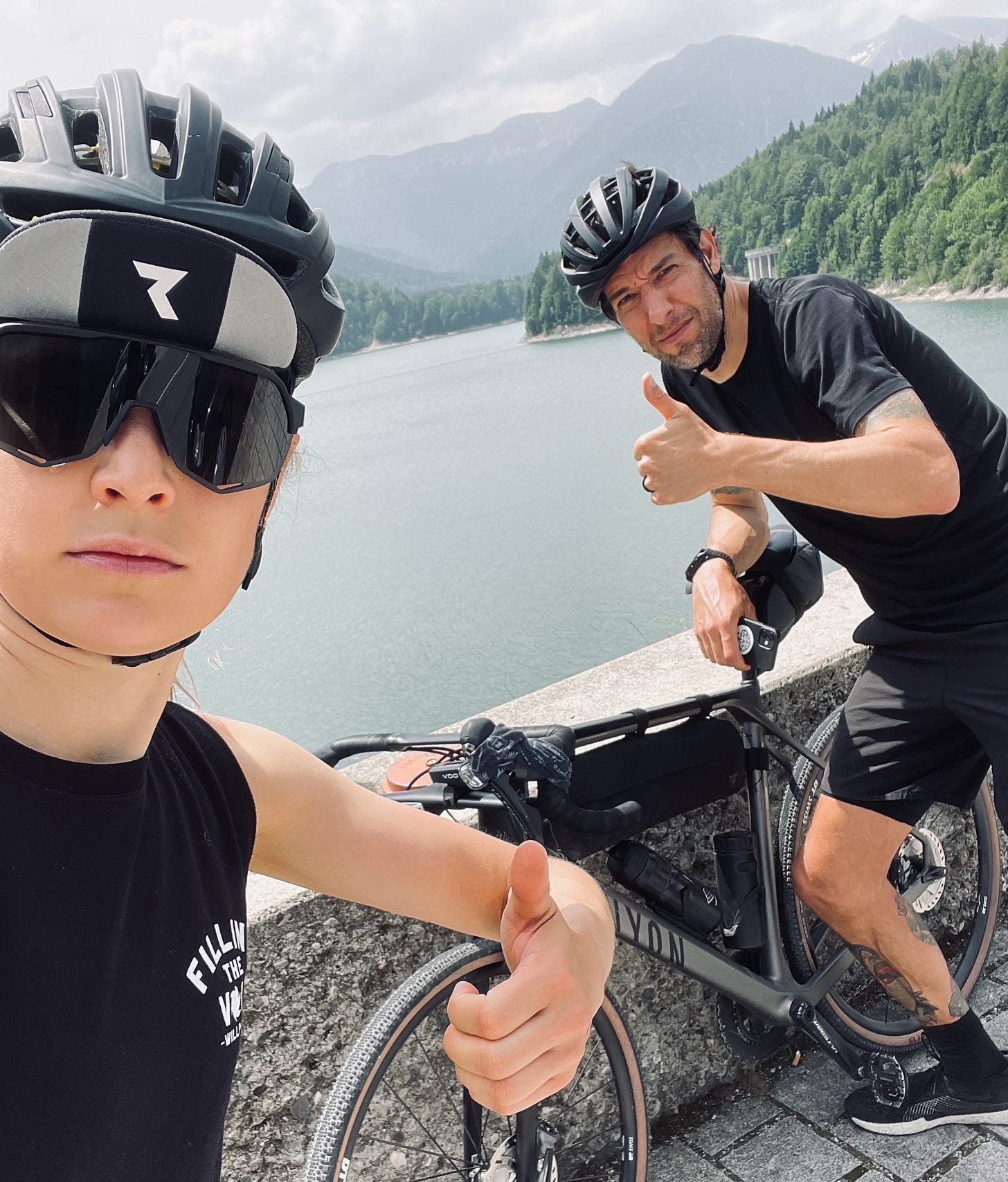Today you might be Without, but you always have it Within
It is not exactly a coincidence that this Das Z Letter deals with the topic of injury (again). Today also marks the launch date of a new collection for my running brand, Willpower, which addresses exactly that: Not being able to run. Welcome, Without - Within.
If something is lost, it can be found

Being injured sucks
Let’s face it, being injured sucks. I had the dubious honor this year of being injured for almost 3 months. It was the first time I have been out of order (or better: out of running) for such a long period of time, and my learning curve was maximally steep.
Although I thought about my injury every day, I stopped writing about it at one point. I had the feeling that this would not contribute anything helpful to the matter. Neither for myself, nor for anyone else out there.
Well, in last week’s Das Z Letter, I formally declared the end of my injury. I believe I can now look at and write about it from a different angle. As so often, this is mostly a “Do as I say, not as I do” type of text, so bare with me, if I sound like Mr. Neunmalklug.
Here are my…
6 Hard Truths About Injuries
Injuries are unavoidable and everyone is injured all the time
Injuries do not fall from heaven - You can see them coming
Being injured is not about guilt - It’s not (really) your fault
The best and only remedy is patience
You’re never going to heal completely, but you can learn to manage your injuries well
BONUS: Alternative sports sucks
1. Injuries are unavoidable and everyone is injured all the time
So you’re newly injured and think you are special? Don’t flatter yourself. We’ve all been there, we’ve all done that. The reality is that every runner gets injured sooner or later. No exceptions. Some might be more outspoken about it than others, and everyone treats their injuries differently. But in the end, we’re all prone to injury to the same extent.
This is both, good news and bad news.
Bad news because our sport seems to be a real meat grinder of bones, muscles, joints, and tendons. I haven’t met one single person, who managed to practice running as a true “health sport”. Whatever that means, anyway. It’s just hard for the body, no matter if you only run occasionally or every single day. We all should be aware of this.
The good news is, that you’re obviously not alone. The injured are almost like another community within the community of runners. It usually makes being injured suck a bit less, if you speak to other affected persons. Furthermore, you can profit a lot from their experience. Even if you believe that you have a super rare, mega exclusive running injury. Be sure, someone else had it before, and you will find him/her on the internet.
2. Injuries do not fall from heaven - You can see them coming
Yes, it’s not fair. And yes, the timing could not have been worse. And no, there’s no plausible answer to your melodramatic “Why me?!” question. But….
You could have seen your injury coming. I am not talking about Karma here. I really mean it, when I say that (almost) no injury falls from heaven. Instead, they creep in.
The most obvious example is the runner who never stretches. He/she is going to get stiffer and stiffer, lose more and more flexibility and range of motion, and will not run smoothly anymore. That’s when an injury is preprogrammed.
A not so obvious example is the runner who trips over a stone and ruptures his/her tendon. That’s just bad luck? I don’t think so. We almost always trip and stumble when we’re not attentive. And usually, we’re not attentive when we are tired, fatigued, or burned out. And being tired, fatigued, and burned out is something that creeps in. We see it coming. And we can take preventive measures.
I don’t even want to mention the runner who “runs through” an obvious pain or previous injury. I will pick up this delicate topic again in 5.) You’re never going to heal completely, but you can learn to manage your injuries well.
3. Being injured is not about guilt - It’s not (really) your fault
One of the first thoughts that rush to our heads when we get injured is:
“What did I do wrong?”
Well, yes, you could have listened to your body. You could also have practiced better self-care. And maybe that hard workout after that hard workout in that hard week was a bit too hard. But this doesn’t matter now. You’ve been kicked into this wholly new situation, and feeling guilty will make things much worse than they already are.
“I’m such an idiot. I could have - should have - would have…”
will get you nowhere now. A much smarter attitude to tackle this new challenge is to make peace with what has happened (and yourself), and look for smart and effective ways to heal and recover. That’s really all that matters now, and you will need all your P.M.A.(*) to stay focused on that goal. So don’t be too hard on yourself.
Maybe truth #1 of this list will ease your self-criticism. Everyone gets injured. All the time. So whatever you did to get yourself in the situation you’re in, it couldn’t have been that irresponsible.
4. The best and only remedy is patience
If there is one thing that all scholars, all practitioners, all physiotherapists, and all athletes agree upon, it is that patience is the magic sauce that will end all injuries. There is literally no other way to get out of your misery, then giving your body time to heal. The more serious your injury, the more patience you require.
Yes, it’s that easy. And yes, it’s that hard.
Patience usually does not belong to the key competencies of us runners. We want plenty of things, and we want them fast. But what consistency is to progress, patience is to healing. In fact, these two concepts are even interconnected.
Short and simple: No matter how smart your doctor is, how capable your physiotherapist and how ambitious you do your rehab exercises, it will take time.
And again: It will. Take. Time.
5. You’re never going to heal completely, but you can learn to manage your injuries well
I thought a while about whether I add this point to the list or not. I would rather not glorify a picture of the “always injured runner”. There’s nothing cool about being injured or impaired as a runner.
Yet still, I learned the hard way, that some of our aches and pains will only fully disappear if we quit running for good. To most of us, this is not even the slightest option. So there must be another solution. And that is injury management. Or better, physical complaint management.
Instead of expecting our bodies not to hurt (which won’t happen as long as we run), we could also focus on keeping our weak points in check. For example, a 2/10 achilles tendonitis pain for the first 1 km of a run won’t affect us very much. As soon as it turns into a 5/10, and you can’t even walk to the bathroom anymore without limping, it becomes a real problem. If we find ways to keep the achilles tendonitis under control, we’re on the safe side.
What I am suggesting is a bit like the smart version of “running over it”.
The sad news is, that this does not work with all physical complaints or injuries. If your foot is broken, it’s broken. There is no “management” or “running over it”. You need to immobilize it and wait for 6 weeks. No other options available.
But there’s quite a few other aches and pains that become our companions over years of running. To manage them properly means to learn to live with them and not letting them rob us our joy of running.
6. Being injured is a state of mind
I won’t write anything about this crucial truth, since it was the main topic of last week’s Das Z Letter, that you can read here:
7. Alternative sports sucks
Cycling is not running.
Swimming is not running.
Hiking is not running.
Yoga is not running.
Skiing is not running.
Climbing is not running.
Pumping iron is not running.
Spinning is not running.
Not running is not running.
Only running is running. Sad but true.
Everything not Running
Allow me to introduce you all to the new Das Z Letter logo. Yes, it’s silly. Yes, it’s comical. Yes, I don’t need a logo to make you all read my texts. Yet still, I’m stoked about it!
The logo was created by my go-to designer Don aka Dedonleon, who was predestined to do the job. His bold and chunky design style always speaks a clear language and is one of a kind.
If you didn’t know: “Das Z” has its origin in my rather complicated family name “Zehetleitner” which no human on this planet can pronounce or spell correctly.
On a more serious note, the letter “Z” has been pretty much dragged through the dirt but Russian forces since the beginning of their brutal and unjust invasion of Ukraine. The danger of being misinterpreted was one of the reasons for me to create a new logo. The new “Z” now clearly looks different from the symbol those filthy warmongers draw on tanks and house walls. There is also a stronger connection with the prefix “Das” to make it even more obvious that I am not supporting Russia’s war of aggression in any way.
However, this whole issue made me reflect about sovereignty of interpretation. Who “owns” a symbol? Or a letter, for that matter. At which point is a symbol lost forever, like the swastika or the quasi-esoteric runes insignia of the Schutzstaffel? What measures can be taken to cleanse and purify a symbol that has been misused for something bad?
These questions are difficult to answer, but I am convinced that we must not allow Russian propaganda to snatch away a letter from our alphabet. Let alone the most beautiful one.
Sprachnachricht
A new Sprachnachricht with a new microphone. Can you hear it?
(*) Positive Mental Attitude (P.M.A.)
P.M.A. stands for “Positive Mental Attitude”. A term and philosophical concept coined by the self-help pioneer Napoleon Hill in his 1937 book “Think and Grow Rich”.
Many people believe that legendary hardcore-punk band Bad Brains brought up the term for the first time. Although this is not the case, their song “Attitude” still is one of the most important genre-anthems ever written and has influenced generations of hardcore-kids regarding their way of life. That’s why it deserves a special place in this week’s Das Z Letter.
Song Text
Don't care what they may say
We got that attitude
Don't care what they may do
We got that attitudeHey, we got that P.M.A.
Hey, we got the P.M.A.Don't care what they may do
We got that attitude
Don't care what they may say
We got that attitudeHey, we got that P.M.A.
Hey, we got the P.M.A.We got that attitude
We got that attitudeHey, we got that attitude
Hey, we got that attitudeDon't care what they may say
We got that attitude
Don't care what they may do
We got that attitude









Hi - I appreciate your point of view, but as a longtime running coach and someone who's been running for 25+ years, I'd like to offer a different point of view. Some injuries ARE avoidable. For example, many women get stress fractures from a combination of low energy (not eating enough) which leads to amenorrhea (loss of periods) which leads to weak bones. This is preventable, and it's important that young female athletes get this message. Other injuries, such as Achilles tendonitis and other forms of tendonitis, usually result from a combo of overuse and poor biomechanics. Both are preventable. Injuries are great teachers -- they can show what needs to be altered in training and what needs to be improved for biomechanics (i.e. flaws in our running form). And why the point "you're never going to heal completely"? That is just not true. I know runners, for example, who coped with a calf strain or a glute pain for months -- but when it finally went away, it did not come back, because it had healed and they had improved their running form and took other precautionary measures to make sure it did not return. Finally, "the best and only remedy is patience" is not necessarily true. There's a lot you can do while injured, in terms of physical therapy, bodywork, and nutrition, to expedite healing.
No5 was the biggest one for me. Biggest humbler as I got older, for sure. Changed all my targets.